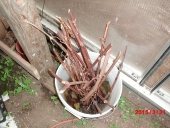
 6
6




 1
1




Regards, Scott
 1
1








Regards, Scott
 1
1








Regards, Scott
 1
1




 1
1




 1
1




Permaculture...picking the lock back to Eden since 1978.
Pics of my Forest Garden
 1
1




"I live on Earth at present, and I don't know what I am.I know that I am not a category.I am not a thing—a noun.I seem to be a verb, an evolutionary process—an integral function of the universe."
Buckminster Fuller
 1
1




 2
2




"I live on Earth at present, and I don't know what I am.I know that I am not a category.I am not a thing—a noun.I seem to be a verb, an evolutionary process—an integral function of the universe."
Buckminster Fuller
 1
1




Michael Littlejohn wrote:I appreciate all the great info.
My reading is that Brown Turkey fig, which is one of the two varieties I have does not require pollination by wasps to set fruit.
I have tried to identify the other fig, which is small, dark with a tannish interior, but I dont have an exact match for it yet. I will meditate a bit on whether to process its seeds.
I was not aware that dried fig seeds would sprout, Im going to research that again. My subjects at this time are fresh figs. I appreciate the agricultural station link and I am going to look into it.
Best, M
Permaculture...picking the lock back to Eden since 1978.
Pics of my Forest Garden
 1
1




 1
1




 1
1




 1
1




"I live on Earth at present, and I don't know what I am.I know that I am not a category.I am not a thing—a noun.I seem to be a verb, an evolutionary process—an integral function of the universe."
Buckminster Fuller
 1
1




Permaculture...picking the lock back to Eden since 1978.
Pics of my Forest Garden




Greg Martin wrote: Pollen can be transferred manually.
"I live on Earth at present, and I don't know what I am.I know that I am not a category.I am not a thing—a noun.I seem to be a verb, an evolutionary process—an integral function of the universe."
Buckminster Fuller
 2
2




Erik van Lennep wrote:
Greg Martin wrote: Pollen can be transferred manually.
So that must be how new varieties get bred. Have you tried it yourself?
Permaculture...picking the lock back to Eden since 1978.
Pics of my Forest Garden
 1
1




"I live on Earth at present, and I don't know what I am.I know that I am not a category.I am not a thing—a noun.I seem to be a verb, an evolutionary process—an integral function of the universe."
Buckminster Fuller
 3
3








Regards, Scott
 1
1




Scott Stiller wrote:Good morning Mike! I love all things fig and grow two varieties. I tried growing them from seed once but was unsuccessful. Even the ones I got to sprout didn’t survive long after transplant. Growing them from a six to eight inch cuttings is super easy though. I used to only start cuttings in March or April but have expanded to three seasons here in zone 7.
I’ve had the most success rooting from last season’s growth. Take your cuttings just below a leaf node and stick in a inch of water. Keep in the shade until roots form. Those fresh roots are extremely fragile so handle with care. Once hardened off give them a good home.
Here, they produce abundantly anywhere from 3-10 hours of sun per day.
Jill of all and Misses of Targets -JMH




Regards, Scott

|
Doe, a deer, a female deer. Ray, a pocketful of sun. Me, a name, I call my tiny ad ...
Solar Dehydrator Plans - Combo Package download
https://permies.com/t/solar-dehydrator
|







